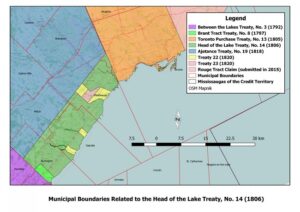Head of the Lake Purchase
 By Dr. David Shanahan
By Dr. David ShanahanBy 1805, the Crown had acquired almost all of the north shore of Lake Ontario around to Niagara, with the exception of a block of around 35 miles frontage at the head of the Lake, between York and Niagara. In 1797, an approach was made by the Administrator, Peter Russell, the interim head of the administration after Lt. Governor Simcoe’s departure, to the Mississaugas. At the time, Joseph Brant had been named as the land agent for the Mississaugas, following his successful leasing and sale of some of the Grand River lands of the Six Nations, and he was seeking what the Crown considered to be too high a price for the lands. The Crown decided at that time not to pursue the Mississauga Tract, as it was known.
On August 1 and 2, 1805, talks started again, and the Chiefs stated their terms for ceding the land. These included the reservation of three parcels for themselves, at the mouth of the Credit River, Sixteen Mile Creek, and Twelve Mile Creek. They also wanted the Crown to confirm a sale they had made to the Tuscaroras of a piece of land, and a sugar bush they had granted to Joseph Brant’s wife.
One major issue for the Chiefs was the waterfront along the whole stretch of the parcel, which they wished to keep, as they had been forced off the waterfront on other parcels they had previously surrendered through treaty. Claus would not accept these terms and the talks were postponed until the following day when they returned with a compromise offer.
The Crown would reimburse the Tuscaroras for the land they had bought from the Mississauga, and the Mississauga would place their trust in the Crown with regard to the use of the waterfront.
The sugar bush would be confirmed by the Crown, but the three parcels at the mouths of the river and creeks, used by them for fishing, were essential to them and would not be given up.
This led to a preliminary agreement between the two sides, and, once the treaty payment arrived from Britain the following year, the Treaty was formally signed on September 6, 1806. It covered
part of the Mississauga Tract, an area of 85,000 acres, beginning on the east at the Etobicoke River, and running westward to a parcel of land previously granted to Joseph Brant. A Reserve on
the Credit River was set aside, as were fishing stations at 12 Mile Creek and 16 Mile Creek. These reserved parcels were shown on a sketch which accompanied the Treaty document, along with the
list of trade goods to the value of £1,000 “of lawful money of Upper Canada”, which was the price paid by the Crown for the land.
One unusual aspect of this treaty was the signing of a year-long lease for the same property. It was drawn up and signed on September 5, 1806, and covered the same land as the official Treaty signed the next day. But it was included, according to the treaty documents, “To the intent and purpose that by virtue of these presents and of the statute made for transferring uses into possession His said Majesty may be in the actual possession of the premises, and be thereby enabled to take and accept a grant and release of the freehold reversion and inheritance of the same premises and
every part and parcel thereof to him His said Majesty, His heirs and successors, to the uses into possession His said Majesty may be in the actual possession of the premises, and be thereby
enabled to take and accept a grant and release of the freehold reversion and inheritance of the same premises and every part and parcel thereof to him His said Majesty, His heirs and successors,
to the uses to be declared by another Indenture, intended to bear date the next day after the day of the date hereof.”
The price paid by the Crown for this lease was “five shillings apiece of lawful money of Great Britain”, and if the lease was to be renewed, the price would be one peppercorn, which was a legal
fiction and meant a nominal or no rent.
The Head of the Lakes Treaty, along with the Toronto Purchase of the previous year, finally gave the Crown control over the entire waterfront along Lake Ontario, although the final settlement of the land’s status had to wait until the Williams Treaties of 1923.


